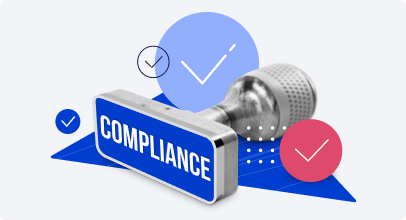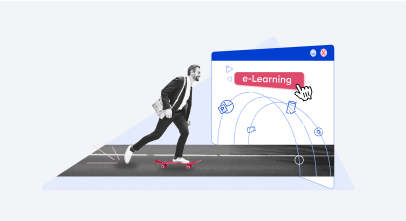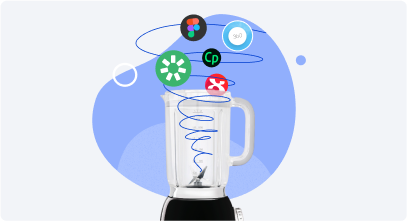eLearning Project Implementation – 7 Steps to Success

Launching eLearning in a company is like doing the same with a spacecraft – it requires a detailed strategy, teamwork, investment, and much more.
In this article, together with eLearning experts, we’ll analyze the entire cycle of implementing digital learning and explain how to put eLearning into orbit in 7 steps. Check out this infographic for an overview of steps you need to take and continue reading the article for more details.

Step 1. Define the Learning Objective
A rocket might be launched into space for various reasons: to explore a new planet, to put a satellite into orbit, or to deliver a payload to astronauts, for example. There must always be a goal. It’s the same with digital learning — there’s no sense in using it just because it is fashionable. If you’ve opened this page, it means that you already realize why your company needs online training. Just try to transform your idea into a clear objective.
What do you want to achieve with eLearning? The more specific the goal, the more likely you are to make it happen.

After your goal is set, think about what other benefits you hope to get from online training. That’ll better prepare you for the next step, which is choosing eLearning tools.

Leslie Cutter, global digital marketing manager at Moxa Inc.
“The mission of our Global Digital Marketing Department is to build marketing automation capability at Moxa on a global scale. We set a goal to simultaneously train marketing teams from different countries on the basics of content marketing and social media marketing. Before moving forward, we also identified our key training needs:
- Train at a time that is convenient for our learners
- Provide a depository where they could refer back to the training
- Record and track training records
- Manage the comings and goings of a dynamic training audience
- Add new training quickly and easily
- Communicate to our learners through the training system”
Outcomes of Step 1: You’ve set your learning objectives and identified your training needs.
Step 2. Choose the Right Training Tools
How is a spacecraft made? Experienced rocket scientists would say something like this: “Various rockets are constructed in different ways. It all depends on the task.” For example, the American Space Shuttle has starter boosters, a fuel tank, and an orbital module. This is enough to achieve a low Earth orbit. But if you want to get to Mars, you need a spaceship of a different construction.
The eLearning arsenal also depends on the goals. As a rule, companies use one of these two types of tools, or the entire set at once:
- learning management system (LMS)
- eLearning course authoring tool
Let’s take a closer look at each of these.
Learning Management System (LMS)
An LMS is a virtual school where you can teach your staff from anywhere in the world: assign courses and tests to learners, track their performance, and analyze their results.
With an LMS you can:
- Create a knowledge base. Your e-courses, assessments, videos, and other learning materials are stored in one place. This is a much more reliable and convenient way of storing content than using flash drives. Employees can enter the portal and review the material at any time.
- Train your staff remotely. You can assign a course to a particular employee, department, or the whole staff with a couple of clicks.
- Monitor the quality of the training. An LMS collects detailed statistics on each content item, user, and group. You’ll always know exactly how your employees are learning and evaluate their progress.
- Keep in touch with students. An internal chat or forum is a place where employees can exchange their ideas and share their opinions on which materials were especially useful, what to improve, and what topics to cover.
When it comes to selecting an LMS, choose between a locally hosted or a cloud-based system.

Jeff Dalto, Senior L&D Specialist at Convergence Training
“The first consideration is speed and effort: you’re going to find setup and implementation of a cloud-based platform to be faster and easier than you would with a locally hosted LMS. Employees will generally find it more user-friendly, meaning they’ll spend less time learning how to use the system and more time using the LMS to acquire valuable work skills. Updates will also be faster and easier, as your LMS provider can simply push updates to the web-based system.
The second set of benefits revolves around your IT department and, most specifically, not having to make requests of them. The LMS provider will set up, update, monitor, and maintain the LMS for you, meaning you won’t have to bother the IT staff for this. And IT will appreciate being able to save bandwidth on your internal servers for other mission-critical tasks.
If these benefits aren’t sufficient, there are still other reasons to go with a cloud-based solution, including increased mobile friendliness; faster delivery of training, better data security, and more effective disaster recovery. See our benefits of a cloud-based LMS article for more on all of these points.”
eLearning Course Authoring Tool
In addition to an LMS, you’ll need software for building courses. You can buy an easy-to-use tool with all the necessary modules for rapid authoring or a powerful solution with a software simulation editor and even capabilities for creating VR projects. It all depends on your learning objectives and the time and energy you’re ready to spend on training how to use the tool.
To choose the right software, you need to focus on the demands that will be made on the tool.

David Patterson, Director of Learning Light
“How quick and intuitive should the learning development suite or tool be? Should it have an option for embedding video and other assets? Сan you start with simple PowerPoints and build from that? What about gamification? Ideally, you should build a features checklist for the content creation capabilities you need.
Please keep in mind that assessments and quizzes are important features that support learning and play a huge part in learning and knowledge transfer. Creating meaningful questions in an engaging manner is a real skill that is too often neglected, in my view.
Don’t overlook the need to understand learning standards and learning analytics. Make sure the tool you choose is flexible enough to cover your demands for the eLearning modules to work in your LMS.”
Here, you can see an example of an e-course created in the iSpring Suite toolkit.
Here is the way an e-course is created in the iSpring Suite toolkit.
After you’ve installed iSpring Suite on your computer, you’ll see a special toolbar in PowerPoint.

Right from the iSpring Suite toolbar, you can enhance your presentation with tests, interactions, images, audio, video, and dialogue simulations. Then, you can publish it to your LMS and assign it to your team members.
Your employees can view the content at any time and from any device: a desktop, a tablet, or a smartphone.

Jill Brown, quality management coordinator at Villa St. Vincent
“With iSpring, our company creates online courses for new employees to become Certified Nursing Assistants (CNAs).
Our training program consists of 15 units, and within each unit are modules. All in all, there are 58 actual modules — or PowerPoints.
I use iSpring Suite to enhance the modules with a variety of teaching methods: lectures, simulations, videos from the web, instructor-led video teaching, web links for additional references, essays, and quizzes. Each unit also includes handouts, practice quizzes, etc. In addition, iSpring Suite provides many design features to keep the content interesting.
Depending on the length and detail of the materials, it takes me approximately 4-8 hours to complete a working module, including simulations, videos, and tests. The other authoring tools I tried took at least twice the time.”
This is an example of a Villa St. Vincent e-course created with iSpring Suite:
Outcomes of Step 2: You’ve defined what kind of eLearning tools you need, analyzed the eLearning market, and selected the solutions that meet your requirements.
Step 3. Produce a Budget and Action Plan
How much does it cost to launch a spacecraft? For example, the average cost to launch a Falcon 9 rocket is about $62 million per mission, and the NASA SLS system costs around $500 million to launch each time. The cost depends on the objectives and resources that you use.
After you’ve set a goal and selected the tools, it’s much easier to estimate your future eLearning investments. The expense sheets should include not only the cost of eLearning software, but also the salary for your team, investments in course development and, in some cases, buying new computers for your employees.
After your budget is established, it’s time to create an action plan. Break down your current goal (launching eLearning) into clear, actionable steps and set deadlines for each step.
Example: A vendor needs two days to implement an LMS; it’ll take you five days to create a course and five days to run the pilot project.
The next step is to present the plan to your senior managers. You need to explain to them what eLearning is, how it can drive the business, and what resources are required. The information should be brief and carefully worded.
You need to present the following information:
- Project goals from a business perspective. For example, reduce face-to-face training by 40%, shorten the time for new hire onboarding from 30 to 20 working days, and so on.
- The benefit to the company — how much money it will save or earn. For instance, let’s say a company called Sweet Life is about to introduce a new chocolate bar, and now you need to tell 3,000 sales representatives. Face-to-face training will take you two months and x dollars. To train your employees with eLearning, you’ll need only five days and y dollars. How much is x? It all depends on how much money you were already spending on transportation, accommodations, office space, and other logistics.
- Necessary resources: an LMS, an authoring tool, computers for employees at affiliates, and a course developer.
- The project budget: implementing eLearning will cost you y dollars.
- When to expect the result: the project will be launched in n days.
Outcomes of Step 3: You know the approximate cost of your eLearning project, your management has approved the budget, you have an action plan, and you know the eLearning launch date. Now it’s time to buy training tools and get to work.
Step 4. Prepare the Learning Content
An LMS without content is like a spacecraft without fuel and flight plan. After the system is installed, you need to upload the learning content to your platform: presentations, books, instruction manuals, videos, and online courses.
Ideally, you should have an eLearning development plan for a year or two in advance and a list of training materials that your learners should view. But initially, it’s enough to create one e-course to test the learning experience and conduct a technical run-through.
If you’re planning to build new courses regularly, you’ll need at least one instructional designer who will decide what type of learning materials to develop, and how a course should look, and then create the course using an authoring tool. You’ll also need a coach and one or more SME who will provide the instructional designer with relevant learning content.

Shanavaz SF, Senior L&D Manager at Mycoach Learning
“If you have content that is proprietary/confidential by nature (pharmacy, personal finance) or requires frequent updates (compliance), you’re likely to decide to build an eLearning team internally.
If your organization’s learning content doesn’t change much over a considerable period of time, you’ll probably outsource eLearning content creation. It may also be due to delivering generic content to your employees (soft skills, technology) which is not confidential and poses no threat if/when shared with outsiders. Also, you may opt for such avenues when you feel the learning content on the required topics is available off the shelf from eLearning service providers.
But when you select this channel, take care to select the right vendor to entrust the task, as changing service providers in the middle of a project is quite cumbersome and you don’t want to take that route in any given situation. So evaluate before committing.”
Outcomes of Step 4: You’ve uploaded one or two e-courses to your LMS for a pilot project.
Step 5. Run a Pilot eLearning Project
Before launching a rocket, engineers do a dry run. They let the craft follow a ballistic trajectory without putting it into orbit. This helps them identify any potential errors before the actual flight.
Instead of assigning a course to all your employees, ask a small group to take it. This pilot course will help you define the constraints and difficulties in using your LMS and know if your course is effective.

Brian Simms, Director of Digital Content and Learning Services at Learning Tree International
“When kick-starting your eLearning project, you need to form a steering committee of decision makers in the organization, course authors, and some employees with instructional design and eLearning experience. This can be a group consisting of about 10 people. That feels a bit large when there’s disagreement, but since you have a good mix of those directing and doing the work, it helps to propel you forward once an agreement is reached.
While learners are taking a pilot e-course, it’s important to survey them on how they feel about eLearning to rate their confidence in what they’re studying and describe things that are still not clear to them. After the course, it would be good to present this information again and verify that the students are leaving the course satisfied.
This data can serve the creator as a gauge for the effectiveness of the specific modules within the course. This insight also provides validation for the student’s organization that investing in learning for their employees is a worthwhile effort. Most importantly, it offers proof to the student that they haven’t wasted their time if they can sit back and say, ‘I really have learned something here.”
Outcomes of Step 5: You’ve run the pilot eLearning project, received a list of valuable comments from the focus group, and gone through the error correction process. Now, you’re ready to launch your full-fledged eLearning project.
Step 6. Motivate and Support Employees to Access eLearning
Once online training is underway, motivate and engage your employees to access eLearning so they feel enthusiastic about your corporate training and strive to learn even more.
You can do this using the following techniques:

Barbara Davis Robinson, Director of Organizational Development and Learning at WellDyneRX
- “Make access easy. Nothing is more frustrating than not knowing where to go and how to access a class that you need or want. Keep sign-on as simple as possible, including password resets when needed.
- Offer variety. In addition to the classes that employees have to take, host or offer classes focused on other topics your employees are interested in.
- Keep the class short, if you can. Learning “nuggets” help students retain content and motivate them to watch again when they need to. Drudging through a 90-minute class again looking for information you need is frustrating and, most of the time, isn’t going to happen.
- Draw your staff in quickly. Use strong openings and provide valuable information early on in a dynamic way.
- Keep employees interested. Use multimedia methods such as video and audio. This sets the tone that it’s not just another boring, required class they have to take.
- Provide recognition and feedback. Most people love to be recognized. Know what you can do with your learning technology to recognize people creatively. Depending on the class, instructor feedback to students or discussion between students can expand and clarify learning.
- Share success stories. How did your employees use what they learned to help them both professionally and personally? In one example, a company offered weight loss classes and an employee lost over 100 pounds. The person was recognized later in the company newsletter as someone who benefited from what was offered.
- Use humor. Humor can be very beneficial to make people laugh and motivate them to keep watching. It is often followed by conversing positively with others about their experience, which helps create interest among other employees. The key is to use proper and appropriate humor so you’re not insulting anyone. Be sure to get approvals and consensus with your leadership on any humor you’re using.”
Outcomes of Step 6: The employees support eLearning and actively take courses.
Step 7. Evaluate eLearning Effectiveness
The craft known as eLearning has now achieved lift-off. You’re at the helm. Your main task now is to stay the course.
Here’s how you can understand that you’re going in the right direction:
- Collect feedback from your employees
- Compare the achievements of learners who attend face-to-face classes with those who study online
- Assess your employees’ knowledge regularly
- Keep track of the learning process and monitor how your employees’ work performance improves
To learn more about how to measure eLearning effectiveness, read our blog post about training metrics.
Outcomes of Step 6: You can see how well your employees understand the learning material and if they can apply their new knowledge in practice.
Key Factors of Successful eLearning Implementation
When running an eLearning project, it is essential that you face some challenges that prevent you from attaining orbit: budget, deadlines, and employee sabotage, to name a few. But one of the most damaging issues is not understanding whether you’ve really finished the project successfully.
Let’s take a look at five factors and related questions that allow you to measure its success:
- Timeline. Did you finish the project by the deadline or did you need extra time to complete it?
- Scope. Did you complete each step within the allotted timeframe? Did you manage to get all the necessary software, prepare learning materials, and run a pilot project?
- Budget. Did you project all expenses accurately in the beginning? Was the project completed at or under budget?
- Employee engagement. Does your staff feel engaged in training and ready to invest their time in eLearning or do they resist or even refuse to take courses?
- Goals. Did you achieve your first training goals? For example, do your sales reps now know the product line inside out or have you reduced the time for onboarding new hires as intended?
These are all things that will help you define how successfully you implemented your eLearning project, what still needs to be fixed, and in what direction you still need to go. But you can be confident that you’ve finally put eLearning into orbit only when the training process goes smoothly and helps you solve your actual business needs.
To learn how to evaluate what online training brings your company in terms of numbers, read our article on how to measure eLearning ROI.
Also read: Remote Employee Onboarding
Best Practices for Implementing eLearning
Even if you’ve designed the best eLearning program on the planet, it won’t matter if none of your employees care. Throughout every step of your launch, the goal is to simultaneously raise awareness of your program and pique your employees’ interest. We’ve already explained how to engage employees once online training is underway, but this is how to “advertise” and present the idea of corporate eLearning to your team members in the initial stage.

Andrew DeBell, Training Consultant at Water Bear Learning
“A successful eLearning launch starts with three core components: a strong sell of the “why,” a compelling communications plan, and an amazing first impression.
- Selling the “why” behind your eLearning means thinking through the core purpose of your program, not just for the business, but for the employees themselves. They must have a clear and simple answer to “what’s in it for me?” Will your eLearning help them grow in their careers? Will it help move them closer to a promotion? Before you begin designing the rest of your communications and launch plan, be very clear about the “why” for employees. This “raison d’être” should be one simple sentence that is clearly understood by all.
- Creating a compelling communications plan is another way to ensure the success of your eLearning launch. Start by mapping out the full scope of your launch, from initial contact to conclusion. Your plan should involve multiple touchpoints, with goals to move employees from awareness to completion. It helps to have an internal group of change and training champions to help get the rest of the company on board. This group could comprise managers or leaders who can help promote and spread the word about the new eLearning program. Employees are much more likely to take part if it’s suggested by their manager or company leader. Your communications plan should also include engaging materials such as launch videos, practical worksheets, or pre-training initiatives in order to generate support.
- Before you announce your program, be very thoughtful about the first impression your program will transmit. First impressions are incredibly powerful for moving people from awareness to participation. You don’t want to waste this golden opportunity to engage and inspire employees to learn more about your eLearning project. One tip for positive first impressions is to use beautiful, modern designs in your communications. Then make the first step simple and easy. Use a big bold button for registration. Make the sign-up form only require two clicks. Brainstorm some ways to simplify the first step to reduce digital friction. Start with the small wins from the beginning and your eLearning adoption rates will soar.”
Takeaways
- Before you start eLearning, define the direction: where and why you’re flying.
- The construction of your eLearning vehicle (an LMS and a course authoring tool) depends on the goals and objectives of the stellar campaign.
- A detailed action plan will help you “sell” the idea to your senior management and get a budget for the trajectory.
- A dry run will let you identify any errors and debug your eLearning rocket.
- For an expedition to succeed, it must solve a real business task.
- The success of your launch and eLearning “journey” depends heavily on how engaged and motivated your crew is.
- Check the course frequently: collect feedback from employees, assess their knowledge regularly, and compare training results with business performance.













